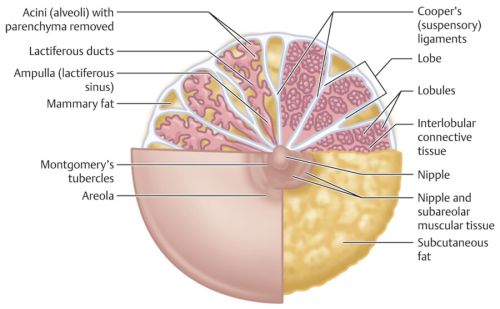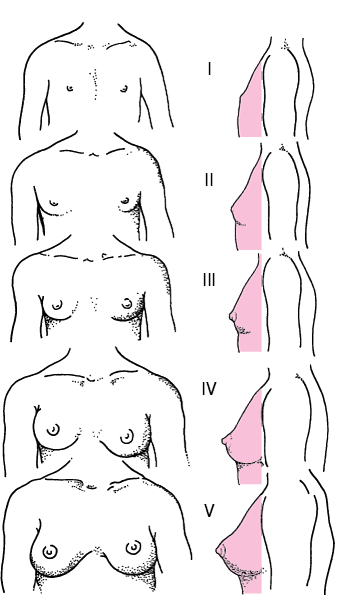No edit summary |
No edit summary |
||
| Line 1: | Line 1: | ||
[[Category:Medical]] | |||
[[File:Breast anatomy.jpg|thumb|500x500px|[https://radiologykey.com/11-breast-anatomy/ Breast Anatomy]]] | [[File:Breast anatomy.jpg|thumb|500x500px|[https://radiologykey.com/11-breast-anatomy/ Breast Anatomy]]] | ||
Revision as of 02:05, 29 November 2023

Anatomy
Breast growth is activated in males and females by the transcriptional regulation of breast tissue cells under the effect of hormones.[1]
Primarily E2 (estradiol) but also P4 (progesterone), Prolactin, Growth Hormone, Insulin-like Growth Factor (IGF), Transforming Growth Factor (TGF-B), Fibroblast Growth Factor, Epidermal Growth Factor (EGF)[2]
The tissue itself is mostly composed of mammary fat, groups of alveolar glands called lobules, ducts which connect the lobules and epithelial lining tissue that gives structure to the lobes and overall shape of the breast. Terminal ductal-lobular units produce the milk that drains into the ductal system and ends up at the nipple.[3]
Tanner Stages

While trans women do not have to directly mirror the hormonal stages of cis women puberty does provide a template for how growth happens using the Tanner scale. An increase in estrogen causes the lactiferous duct system to develop at T2 (~age 9-10), and later an increase in progesterone causes the lobular alveoli at the ends of lactiferous ducts to increase in number at T4 (~age 12-13)[4]
T1 - Pre HRT - Nothing to see here
T2 - Within 6 weeks of starting HRT - Breast area becomes tender and the formation of “buds,” under the nipple commences. If you squeeze your breast area with your finger tips the tissue under the nipple feels denser. It’s common for each breast to grow at different rates. The areola starts to expand.
T3 - Time varies from 6 months to two years - Breasts tissue starts to expand beyond the margin of the areolas. The areola also increase in size and may change colour and Montgomery glands form within the areola. There is further breast enlargement, but there is no distinction of the areola from the contour of the underlying breast.
T4 - 2 to 3 years - the areola now moves away from the contour of the underlying beast and rises up. When looking from the side there is a distinct sereparation of the two structures. Breast tissue continues to grow.
T5 - Up to 5 years. Areola moves back and flattens out but not completely. The diameter of the areola reaches its maximun. The breast reaches mature size and fullness.
Optimal Estradiol Levels
Elevated female levels (preovulatory) initiate breast growth but high levels may not be necessary for more growth. Some evidence shows lower estrogen levels result in more breast cell proliferation.
https://scihub.unblockit.foo/https://www.sciencedirect.com/science/article/abs/pii/S0960076006001567
Progesterone
https://academic.oup.com/jcem/article/104/4/1181/5270376
- ↑ https://www.ncbi.nlm.nih.gov/pmc/articles/PMC4596764/
- ↑ https://academic.oup.com/jsm/article-abstract/11/5/1240/6958171https://www.sciencedirect.com/science/article/abs/pii/S0720048X09001314https://www.sciencedirect.com/science/article/abs/pii/S0899707121003399https://www.ncbi.nlm.nih.gov/pmc/articles/PMC3320255/
- ↑ https://radiologykey.com/11-breast-anatomy/
- ↑ https://www.ncbi.nlm.nih.gov/books/NBK534827/
Pages in category "Breast Growth"
The following 2 pages are in this category, out of 2 total.